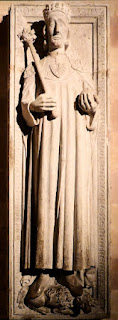When I read or hear Berliner or Hamburger, I think about the food first and then
about the citizens of Berlin or Hamburg. Lately, I read an article in the weekly
Die Zeit Hamburgische Burgerschaft. This is another pun
concerning "hamburger." In German, the last word is instead spelled
Bürgerschaft and means the city-state's parliament.
A Freiburger is a citizen of Freiburg, or?
Red Baron blogged extensively about
Currywurst
and
Döner
but mentioned hamburgers only sporadically.
So here is my blog about the hamburger, starting with some basic
knowledge I read on Wikipedia:
The origin of the word "hamburger" has not been handed down. What is
certain is that the first syllable, "ham," has nothing to do with the
English "ham" (Hinterschinken). Instead, "hamburger" is the short word for
fried minced meat (hamburger steak), which Hamburg immigrants introduced in
the States in the 19th century.Going back in history reveals that street vendors in ancient Rome
already sold
isicia omentata, a meatball made of beef, refined with
pine nuts, pepper, and wine.
In the 19th century,
Karl Drais, the bicycle inventor, allegedly developed the meat grinder, and the raw
minced meat, the steak tartar, became popular.
Since 1802 the entry "hamburg steak" existed in the Oxford English
Dictionary, describing a "hard slab of salted, minced (ground) beef, often
lightly smoked, mixed with onions and breadcrumbs."
Instead of a
Hamburger, you find on the menu of traditional German restaurants a
Hacksteak (minced steak) or Deutsches Beefsteak. My mother
used to cook patties as Fleischbällchen (small meatballs). The
Berliners call them Bouletten; in Bavaria, they are known as
Fleischpflanzerl (little meat plants).
In the 19th century, millions of Germans emigrated to the United States
in search of a better life. The "hamburger" crossed the Atlantic, and the
Cyclopedia of American Agriculture states, "The best hamburger comes from lean
meat of the rump."
But what about the burger bun?
According to a legend, the burger bun was invented in Hamburg in the late 19th
century and made its way from there to the United States. The butcher Heinrich
Heckel ran an inn on Hamburger Berg near the Reeperbahn. One day, guests are
said to have asked for something to eat late at night, but Heckel only had
roast, sauce, and rolls, and his cook was ill, so he put the roast between two
slices of roll - and is said to have invented the
Rundstück warm
(round piece warm) still served today in the port city.
The States
know several inventors of hamburgers. After the Civil War, the "gilded age"
made industrialists and robber barons rich but hid the bitter poverty of the
day laborers. They were looking for cheap and readily available food.
When
the 15-year-old
Charlie Nagreen
sold meatballs at a fair in the small town of Seymour, Wisconsin, he noticed
that people liked to keep walking around while eating. So he pressed his
meatballs, put them between slices of bread, and soon became known as
"Hamburger Charlie." So the Wisconsin State Assembly decided that the
hamburger was invented in their state in 1885. In the home of the burger,
Seymore, they celebrate an annual "Burger Fest."
This story is
contested by the towns of Hamburg* in New York State and Tulsa in Oklahoma.
*The U.S. counts 18 places carrying the name HamburgThe chefs Frank and Charles Menches claimed, "We did it with the
hamburger in Hamburg, NY. It is New York's gift to world cuisine." They
celebrate September 18 as the National Birthday of the Burger.
They
only smile about these stories in Oklahoma. Oscar Bilby from Tulsa served the
first hamburger in a bun on Independence Day on July 4, 1891. And they claim
that neither Charlie Nagreen nor the German immigrant Louis Lassen from New
Haven - although he is listed as such in the library of the U.S. Congress -
nor the cook Fletcher "Old Dave" Davis from Texas served a hamburger for they
all placed their meatloaf not in a bun but between slices of bread. "Tulsa is
the real Birthplace of the Hamburger."
Back to the roots: When McDonald's opened their first fast food in
Hamburg in 1976, they boasted, "McDonald's brings the hamburger to
Hamburg."
*






















































